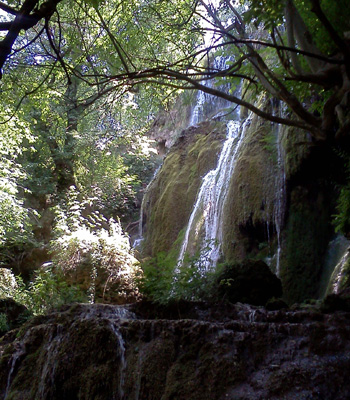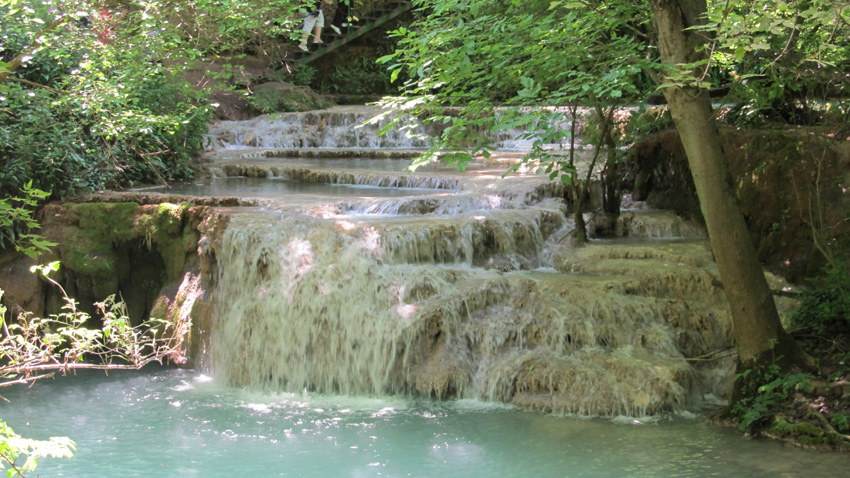Fountains, pools, waterfalls, caves – a magnetic world formed due to the withdrawal of a sea which used to exist here some 120 milion years ago. Only the stunning color of the water reminds of it today and science says it is because of the limestone dissolved from the surrounding cliffs, making the water look bright blue. However, one can barely think of science here, as the magic of the natural phenomenon puts its spell on each visitor.
The Maarata Area with its limestone rocks, caves, springs and waterfalls is situated right above the village of Krushuna. Some of the most attractive and beautiful Bulgarian caves can be found along the Devetaki Highland – the Boninska Cave /2,754 m/, Vodopada /1,999 m/ and Gornik /1,100 m/.
 The water springs from the big Krushuna Cave, threading along the cave galleries, covered with white formations, called Moon Milk. It has strange properties and when squeezed it turns into something like plasticine. Scientists have discovered there bacteria suitable for antibiotics. Further on the waters form the waterfall reach the Blue Pool via a series of thresholds. It is linked to two other smaller waterfalls.
The water springs from the big Krushuna Cave, threading along the cave galleries, covered with white formations, called Moon Milk. It has strange properties and when squeezed it turns into something like plasticine. Scientists have discovered there bacteria suitable for antibiotics. Further on the waters form the waterfall reach the Blue Pool via a series of thresholds. It is linked to two other smaller waterfalls.
Another cave – the Boninska one starts with a dry segment, followed by a water gallery with some 800 m underground lake – the longest in Bulgaria. It is linked to the Vodopada Cave under the ground and they both form a common system with a length of around 6 km.
One more cave is to be seen in the Urushkata Maara area, carrying the same name. It consists of two galleries – a dry and a wet one, merging together at one point. Some limestone ingredient has been released here for centuries, forming a 20-meter-high waterfall. The Urushka Cave is a home of thousands of bats. Nature around is extremely beautiful with so much green and fresh vegetation that everyone is spelled.
Ancient people used to worship spots where water flowed and that were why lots of Thracian sanctuaries existed around the Maara caves. The traces of the Krushuna Hesychast monastery remind of the Medieval Ages on the other hand. Hesychasm was a mystical branch of Orthodox Christianity preaching strong prays and reclusion, in order for unity with God to be reached. The abrupt and nearly unreachable rocks around the waterfall hosted the cells of the monks and a meditation chapel. The Krushuna Medieval Monastery was set there.

There is a green trail along the cascade, 15 wooden bridges and two watching sites. The full tour takes around an hour and a half and a guide might be hired. Spring and the beginning of the summer are the best period for a visit to the falls, when the water and the vegetation around are covered in sunlight and hundreds of birds carry out their magnificent concert.
English version: Zhivko Stanchev
Photos: Yoan KolevNATO tests new 'no U.S.' mission model in Balkans NATO is testing its ability to deploy rapidly across Eastern Europe - without direct US support - as Washington shifts its approach to European defence and the war in Ukraine, the Associated Press..
Love blooms with renewed vigour every year on 14 February! Valentine's Day is increasingly being celebrated in Bulgaria as a holiday that inspires lovers to share beautiful moments together. Traditions include the exchange of cards, gifts and romantic..
From February 14 to 16, an event under the motto "Love and Wine" will allow Sofia residents and guests of the city to combine the Bulgarian holiday of wine Trifon Zarezan with Valentine's Day. It will be held on the pedestrian zone..
The festive service for the consecration of the new Bulgarian Orthodox church in London is led by His Holiness Daniil , Patriarch of Bulgaria, who also..
The Martenitsa Festival was held in Brussels f or the third consecutive year . Cultural organizations from Bulgaria, Romania and Moldova presented their..
Measurement equipment installed at the Bulgarian Antarctic base "St. Kliment Ohridski" has been collecting valuable data on solar activity and its..

+359 2 9336 661
